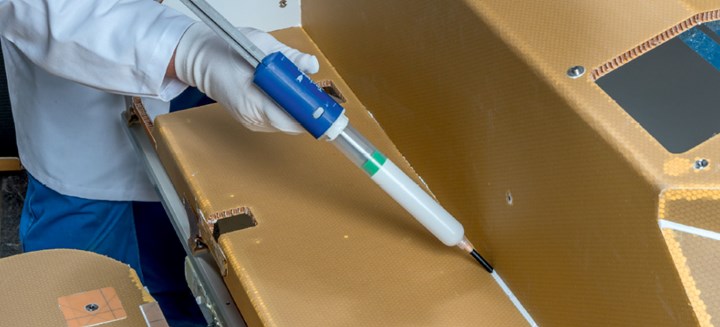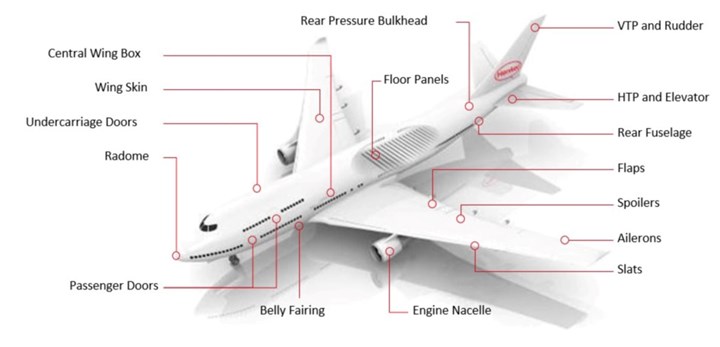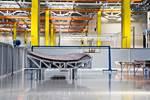Share
Read Next
From the earliest days of aviation, aircraft structures were made of metal. Gradually, aluminum emerged as the preferred option for primary, secondary and tertiary structures because of its lightweight, alloying capabilities, fatigue performance, and lower cost of production compared to other materials.
The latest generation of aircraft incorporates advanced composite materials that can be optimized to specific aircraft design requirements. By weight, both the Airbus A350 and the Boeing 787 are comprised of about 50% composites.
This evolution has been hastened by the many benefits composites provide, such as:
- High strength
- Corrosion resistance
- High strength-to-weight ratio
- High impact strength
- Thermal and electrical insulation
One of the most significant advantages to composites is in lightweighting. The reduction of an aircraft’s weight provides a range of benefits. A lighter aircraft uses less fuel, contributing to sustainability and lower emissions.
Video: The benefits of compound materials
Furthermore, the constant trend to optimize the costs of raw materials and related processing costs has accelerated the application of high-performance thermoplastic composites as alternatives to thermosets. In addition to many of the benefits offered by thermoset composites, high-performance thermoplastic composites offer potential for process optimization by eliminating autoclave curing and refrigerated transport and storage.

Paste adhesives are used to bond aluminum, stainless steel, titanium and composites either in rib-stiffened designs or in honeycomb designs.
CHOOSING A BONDING SOLUTION FOR COMPOSITES
Composite formulations can be tailored, based on targeted application and performance challenges. The range of properties possible within a composite, as well as consideration of other substrates to be bonded, requires careful selection of the right bonding solution to preserve the structural integrity of aircraft components. Adhesives must meet the bonding requirements of different composite materials, joint types and functions, such as:
- Cure speed, and open time before cure
- Mechanical and temperature performance
- Production efficiency
- Thermal properties
Film and Paste Composite Adhesives
Adhesives for aerospace use are typically applied in the form of either a paste or a film. Films, provided in roll or sheet form, are preferred for large-area structural bonding applications, as well as composite parts with a higher fiber content and lower resin content. Pastes can form thicker bond lines to fill and bridge gaps between bonded surfaces.
Film and paste adhesives bring value to the design and manufacturing process in several ways. They can be used to bond two different materials. They also help distribute stress in bond joints, absorb vibration, and are excellent for joining thin substrates.
Film adhesives are pre-catalyzed and are available in defined areal weights in roll or sheet form. They are available in different formulations to provide superior performance under a variety of conditions, including high temperature applications, providing required toughness and durability, and the ability to be co-cured with composites. Films can bond large or small parts, allow a precise amount of adhesive to be used, and can be used with automated tape lay-up equipment.
VIDEO: Film Structural Adhesives for Aerospace Applications
LOCTITE EA 9696 AERO is an example of an industry leading film adhesive. It is a toughened film adhesive for bonding composites, honeycomb core to facesheet, and metals. It offers 60 days of out-time yet cures in less than 90 minutes when heat is applied (248°F/120°C).
Paste adhesives, like films, are also available to meet a variety of performance requirements. They are available in one and two component systems, and room temperature and elevated cure options. Furthermore, they are available in several different packaging configurations for ease of use. In addition to meeting a wide range of bonding needs, there are formulations suited for use as a liquid shim, and for low viscosity wet lay-up applications.
LOCTITE EA 9394 AERO is a popular two component adhesive with outstanding mechanical properties. It can be allowed to cure at room temperature or can be cured in one hour at an elevated temperature. It can also be used as a liquid shim and potting material. It is available in a range of package sizes from 55-gallon drums down to Gram kits.
Time and Cost Savings in Surface Preparation
Surface preparation is an important factor in ensuring a good bond. There are two primary methods for adhesive bond preparation of the surface of a pre-cured thermoset carbon fiber composite: Surface abrasion, and the use of peel ply fabric. With peel ply the labor-intensive practice of sanding is avoided, while also creating a more uniform surface preparation than hand or machine abrasion.
LOCTITE EA 9895 WPP AERO Wet Peel Ply is a pre-impregnated polyester peel ply product that requires no sanding, solvent wiping, or any further processing steps. It provides a more durable bond than dry peel ply fabrics. Supplied in film form, it is compatible with state-of-the-art composite prepreg resin systems and provides minimal residual peel ply fibers at the bond surface after curing and removal.
VIDEO: Wet peel ply
The situation is somewhat different for high-performance thermoplastic composites, like carbon fiber reinforced polyether ether ketone (PEEK), a very low surface energy material which is challenging to bond using adhesives. Surface treatment of a such thermoplastic composite substrate such as PEEK is necessary to modify the surface chemistry and improve wetting, typically accomplished through solvent cleaning, etchants such as chromic acid and other methods. Plasma treatment is currently the preferred method used by many in the aerospace industry, as it provides stronger and more stable surface energy enhancement.
In a recent study, three film adhesives with elevated temperature cure systems were evaluated for bonding CFRP PEEK laminates; LOCTITE EA 9696, EA 9695, and EA 9658. In addition, two paste adhesives were also investigated; room temperature cure adhesive, LOCTITE EA 9394, and elevated temperature cure paste adhesive, LOCTITE EA 9394/C-2.
VIDEO: What kind of surfacing films is Henkel offering?
Adhesive chemistry positively impacted the proficiency of each treatment method. UV irradiation demonstrated improved performance on CFR PEEK with LOCTITE EA 9658, while plasma activation proved more efficient with LOCTITE EA 9695. Both treatments improved adhesion and bond strength significantly compared with no treatment, with peak efficiency strongly dependent upon the chemistry and characteristics of the adhesive, for which the specific surface treatment parameters can be tailored.
Henkel’s range of composite and assembly solutions for primary and secondary aviation structures are helping to define and advance the way modern airplanes are built.

Henkel provides sustainable film adhesive solutions that enhance performance and safety of aircraft as well as the manufacturer’s production efficiency.
COMPOSITE REPAIR: ENSURING ROBUST BONDING PERFORMANCE
In-flight damage from lightning and bird strike are more common than most of us realize. While in-flight damage from such events is expected, other events can also occur while the aircraft is parked at the gate. A bump from a catering truck, a tossed piece of luggage, even the dropping of a tool on a component can cause enough damage requiring repair.
For airlines, the benefits composites provide from their strength to weight ratio, light-weighting and corrosion resistance fully justifies and encourages the acceptance of newer materials in the airframe. Incremental improvements in weight reduction improve the aircrafts’ fuel efficiency, which in turn reduces the airlines operating cost while safeguarding against volatility in fuel costs.
OEM’s are meeting the needs of its airline customers by moving towards more composite airframes and parts.
OEM’s are meeting the needs of its airline customers by moving towards more composite airframes and parts. Inherent benefits of composite parts over aluminum parts come with some additional costs and considerations for the airline. The extent of the damage to aluminum parts can be more visible than damage to composite parts. Undue stress often goes beyond the visible impact on a composite part due to hidden ply damage between layers or across surfaces. As a result, repair technicians are required to inspect and expand the area for repair to safeguard against further propagation, which can lead to a more catastrophic event during service.
Due to the complex configuration of composite parts, consisting of multiple fiber plies, resin, adhesive, honeycomb or foam core consolidated to create highly contoured structures, technical feasibility and material availability will drive the decision to repair or replace a damaged component. If no ready spare replacement for the composite part is available, the airline operator must decide the safest, quickest and most economical path to addressing the composite damage.
For all these reasons, standardized repair practices and readily access to repair materials are critical for an airline operator to improve its on-time performance and fleet utilization. As a result, advanced technologies have been developed to meet the challenge of these repair scenarios. These include film adhesives and pastes that enhance aircraft performance and safety, while meeting stringent OEM requirements for full-scale production and aftermarket repair.
The Repair Process
Whether it is a damaged wing skin, nacelle or cargo door, the options are to perform a repair or order a replacement part if a spare is not readily available. As the latter would keep the aircraft on the ground for a longer period, the repair route might be the best solution, especially for composite repairs that are smaller but still necessary.
Though up to 50% of a modern-day aircraft’s primary and secondary structures may be comprised of composite materials, the basics of a repair assessment and procedure follow the same methodology no matter where they are employed.
- An inspection to determine the degree and extent of damage
- Removing the damaged area
- Treating any contaminated material
- Preparation of the repair area
- Replacing the damaged area
- Final inspection to detect any additional de-laminations or inclusions
- Surface finish restoration
A Standardized Solution
Best practices in how to approach such repairs prompted an effort toward standardization in requirements for repair technicians and their training. That effort has been led by collaboration between key material suppliers, service providers, airline end-users and OEM’s. Consolidation and harmonization of this activity takes place through industry trade consortiums and working groups.
A strong example of this industry collaboration is the characterization of the leading structural film adhesive, LOCTITE EA 9695 AERO, in out of autoclave applications. LOCTITE EA 9695 AERO is ideal for repair applications due to its multiple features and benefits.
- Dual cure at 250°F/121°C and 350°F/177°C for OEM’s and as low as 180°F/82°C for repair
- Autoclave for production and out-of-autoclave capable for repair
- Comparable performance in bonding either aluminum and composites substrates
- 60-day long open time in room-temperature controlled shop environments
- Leading solution for ease of global procurement
This epoxy-based film adhesive tested well for co-cure and pre-cured laminates and demonstrated exceptional environmental resistance. Its ability to cure at lower temperatures made it suitable for repair of composite structures, and its low flow characteristics minimize prepreg resin intermingling. Its consistent performance characteristics within a broad range of cure profiles allowed for a variety of structural component repairs in either in-shop autoclave or on-wing vacuum bag with heat blanket applications. As a result, a variety of OEM’s, Airlines and MRO’s agreed that this was a reliable aerospace grade structural film adhesive for both metal and composite repair. OEM and industry specifications have been written with LOCTITE EA 9695 AERO, thus making it an industry-wide and ready solution.
Additional Challenges and Solutions
The LOCTITE AERO line of structural bonding film and paste adhesives comprises a wide product range that provides performance within a wide temperature range in a variety of forms, viscosities and areal weights for both metal and composite substrates.

As the leading global manufacturer of adhesives, Henkel offers a broad range of potting, edge fill and encapsulating compounds for use with a variety of substrates, operating temperatures and other environmental factors.
The most common repair applications often require bonding and filling of a variety of substrates in many different parts and structures. This results in robust product requirements, with ease of use and material storage considerations driving the selection process. An epoxy-based paste adhesive is preferable, as it will provide the strength, toughness and high temperature resistance of heat curing film adhesives, but with greater flexibility and ease of use. Reduced temperature curing of paste adhesives is advantageous when bonding substrates of dissimilar coefficients of expansion. These solutions can also be applied to large parts via a controlled meter-mix dispensers or dual cartridge static mixer kits.
Paste adhesives also have applications in potting repair within honeycomb structures which is common need in the MRO aftermarket. Preferred solutions will be those with customizable property ranges that cure at ambient (70-77°F/21-25°C) temperature conditions and or lower temperature curing profiles (approximately 180°F/82°C). A paste adhesive with a lower viscosity can be tailored with fillers to adjust its flow and sag characteristics for a variety of repair scenarios.
In addition, there are paste adhesives for wet lay-up repair applications, including laminating, injection and coating. Here a low viscosity mix is necessary for injection into pre-assembled parts. The flexibility of these cured adhesives makes them useful for bonding dissimilar substrates.
Structural paste adhesives with an elevated cure profile up to 350°F/177°C are also used for aircraft propulsion applications like engine nacelles and cold section engine components that may see damage due to impacts from bird strikes or other foreign objects.
It is critical for the repair technician to have a range of options to keep an aircraft flying throughout its 30-year lifecycle.
It is critical for the repair technician to have a range of options to keep an aircraft flying throughout its 30-year lifecycle. As more composite components are added to airlines in commercial fleets, a variety of proven adhesive films and pastes with application-specific characteristics should be readily available so repairs are consistent, reliable and expeditious. Standardized solutions will be selected based on how well they meet and surpass aircraft manufacturer expectations. Commercial availability of said solutions are further improved with a well-defined aerospace authorized global distribution network.



